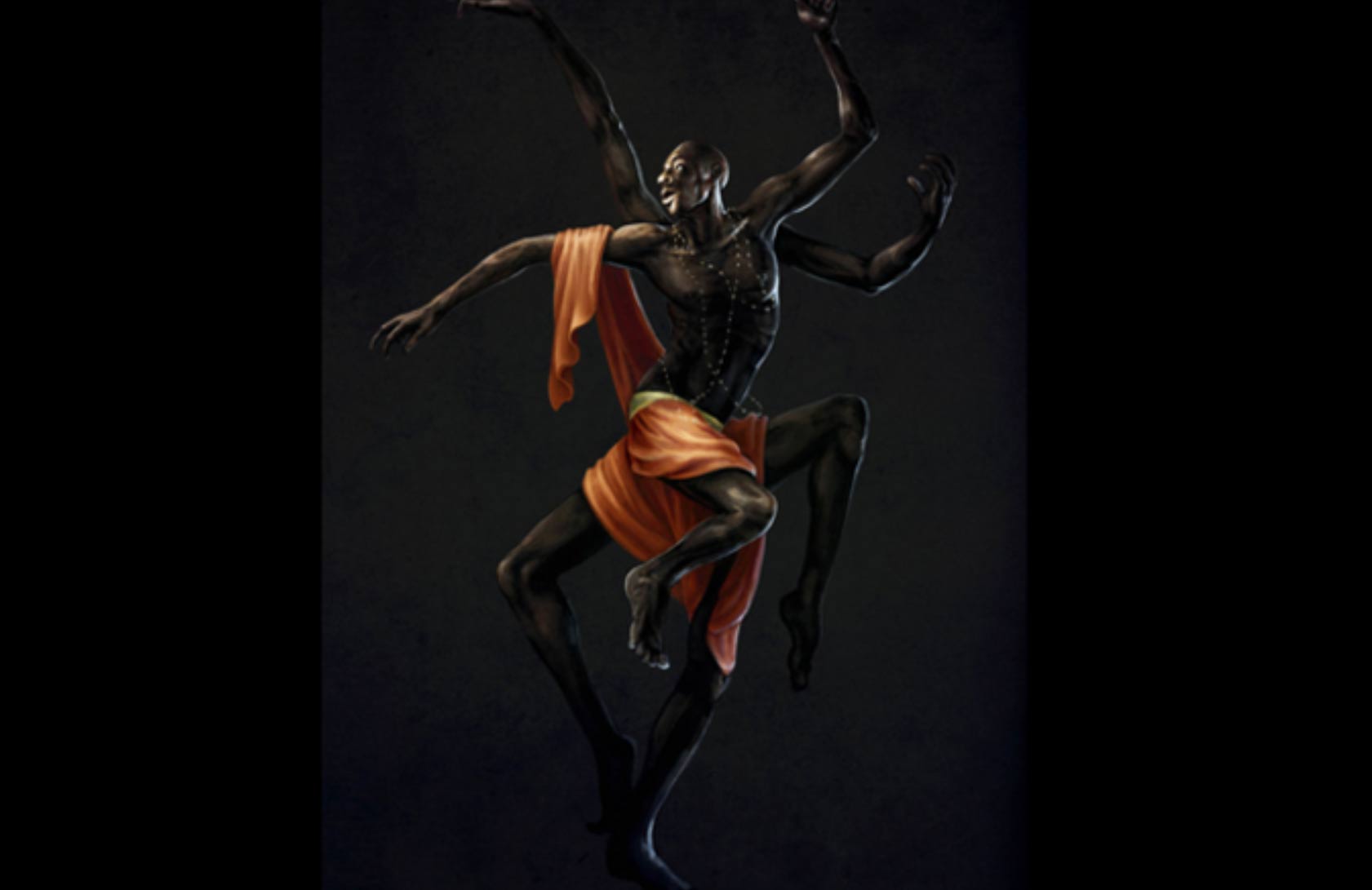The Esan (anglicised Ishan) people are an ethnic group who live in central Edo state in Southern Nigeria. They are one of the three major ethnic groups in Edo state. They are popularly known for farming, hunting, their traditional medical skills and their acrobatic dance called Igbabonelimhin.
Igbabonelimhin is an acrobatic masquerade performance that is sacred to the Esan people not just for its theatrical functions, but also because it serves as a means of communing with the ancestors, cleansing the land of ills and also creating a harmonious society. Like most masquerade performances, music and dance serve as an integral part of the Igbabonelimhin performance.
Origin of Igbabonelimhin
The name Igbabonelimhin is coined from two esan words Igbabo which means "to clap" and elimhin which means spirit. Combining both words together means "clapping for the spirits."
According to Esan mythology, the Igbabonelimhin dance was discovered by a hunter on one of his hunting expeditions. While on top of a tree he saw gorillas coming out of the forest to form two separate groups. One group were making sounds by beating hollow trunks with woods and sticks to produce a rhythm, while the second group somersaulted skillfully in the air to the timing of the beats. He was amazed by what he saw, so he went back to his village and told his people about the strange occurrence. Three other hunters accompanied him back to the forest where he saw the strange event to confirm the truth of his story. The men returned home and affirmed the story of the hunter. The community decided to to learn and preserve the dance, acknowledging it as the will of their ancestors. The hunters taught the able bodied males of the community the dance steps. With the course of time, the dance was developed and accompanied by well balanced music.
Dynamics and Mode of Operation of The Igbabonelimhin Dancers
The Igbabonelimhin masquerade is designed to praise the ancestors of the Esan community whom the living beckon to for blessings and good fortune. These masquerades are believed to emerge from the earth to occupy costumes in which they dance and perform their acrobatic prowess.
Igbabonelimhin masquerades are seen and treated as spirits and not humans. It is the most ancient masquerade of the Esan people and considered to be sacred. In most Esan communities, the Igbabonelimhin group serves as a social cult.
There are two main functions of the elimhin (spirits); which are social functions and ritual functions. When it comes to social performances, the structure of the elimhins is hierarchical.
Social Igbabonelimhin masquerade troupes are made up of the Elimhin (spirits), Okpodu (female spirits), dancers and instrumentalists.
The Elimhin dancers are made up of the Elimhin Oto (ground/earth spirits) who come out to perform before the Odion Elimhin (senior spirits). The Okpodu are female masquerades or can be referred to as the female counterparts of the elimhin. They serve as moderators, keep the audience in good behaviour and evoke encouragements from the audience. The dancers are humans who open the show first before the Elimhin Oto. They perform Esan cultural dances such as Asono and Ojeke to welcome the audience and pave way for the Elimhin Oto. Their dance movements involve shaking of the body and demonstrations with their hands and gentle but calculated movements of legs to the beating of the drum.

The main dancers are the Elimhin/Odion Elimhin who are usually dressed in (Ukpon Elimhin). Their costume consists of an overall of hand woven striped cloth, with a face covering made of net (Ogan) and long hair made up of shredded cloth and fibres. Their costumes are mostly made up of a combination of red, black, and white and any other colour. Varieties of accessories such as mirrors, bells, feathers, bones or cowries are added to either make it look beautiful or fearful.

Days or weeks before a performance, the dancers are fortified against any harm and appeasements are made to the ancestors.On for the day of the performance, a big he-goat is sacrificed to appease the spirits. This sacrifice is most times carried out by the Elimhin priest (Ohenlen Elimhin).The dance performance has two stages or types, the Ikhienlen Oto ( ground dance) and Agheghele (stunts and somersault) .The Ikhienlen Oto (ground dance) doesn't have any form of dance movement that entails somersault. The Ikhienlen Oto (ground dance) as part of Igbabonelimhin dance does not allow for any form of stunts. It is used symbolically, to potray the swift and gliding movements associated with ancestral spirits. This movement introduces the masquerades dancers followed by a special ancestral song. This movement is done mainly with the toes because; the Esan people believe that the ancestral spirits walk on their toes.The Agheghele (somersaulting) dance is only performed when the Ikhienlen Oto (ground dance) has been completed. This movement involves the popular expectation ofIgbabonelimhin dance, which focuses mainly on various forms of somersaults, such as leaps, jumps, stunts, amongst others. Unlike the Ikhienlen Oto (ground dance) dance movement which is dictated by the music. The choice of movement by the Erimhin (spirit) for Agheghele dance determines the pace of the drumming and singing.

Functions of Igbabionelimhin Masqueades
As stated earlier, Igbabonelimhin has two functions; The theatrical/ social aspect which involves dance and its featured dramas and these are performed on special days, including New Year day and during traditional ceremonies or festivals. The ritual aspect is carried out in times when the land may be in need of purification, oath taking or other religious activity.
As regards the ritual aspect of Igbabonelimhin masquerade, there are two types of Elimhin. One of these is the Ojie Elimhin (King of Elimhin/Spirit). Which is different from the dancing Elimhin in size, importance and function. The Ojielimhin usually puts on a long sack like outfit which trails behind and has a larger and more elaborate Ahia that appears at the head of its costume which gives an elevated and heightened appearance which creates a supernatural proportion.
The appearance of the Ojielimhin in public is rare. In some communities it appears annually, while in some communities it appears once in seven or fourteen years. The rarity of its appearances attests the importance of the Ojielimhin. It doesn't dance or entertain during its outings, rather it blesses the village, cleanses the land of of evil and misfortunes.
The second type of Elimhin is known as Elimhin Oto ( Elimhin of the earth) or Imohien Elimhin ( Elimhin that sings at night). Their singing is regarded as crying (uviemhin) and it is carried out at night with the aid of an instrument called the Igue. It goes without musical accompaniment as it goes around the village. Only initiates may see the Elimhin Oto. In some Esan communities, the Elimhin Oto are heard for fourteen nights before the public appearance of an Ojielimhin. While in other communities, they can be heard at the funeral of an owner of an Elimhin costume.
Other Functions of the Igbabonelimhin Masquerade
The traditional Esan believes that the efforts of the Igbabonelimhin masquerade to cleanse the land of the misconduct of individuals in order not to bring harm to the land is a means of reconnecting the living with the ancestors.
The Igbabonelimhin masquerade serves as a representative between the dead and the living. They are seen as ancestors from the land of the dead caring for the needs of the living.
They also banish unrepentant wrongdoers. This ensures the cleansing, and binding of harmony between the human and spiritual cosmos.
They serve as guardians to the human world. They can be used to trace evil acts in the Esan society, which makes them the eyes and ears to the ancestors, bringing peace to the land.
Conclusion
Asides from their thrilling theatrical functions, the Igbabonelimhin masquerade of the Esan people also serve the unique function of bringing the needs of the living to the ancestors, cleansing the land and also restoring and maintaining order in the society.
Reference:
Lorentz, C.A. (1995). Ishan Sculpture: Nigerian art at a crossroad of culture. Columbia University
Images: EsanLand.org

We appreciate your contribution.
Join the Oriire Community
Become a free member to get the monthly roundup, unlock more challenges, comment on articles and bookmark your favourites





















Share
0 Comments